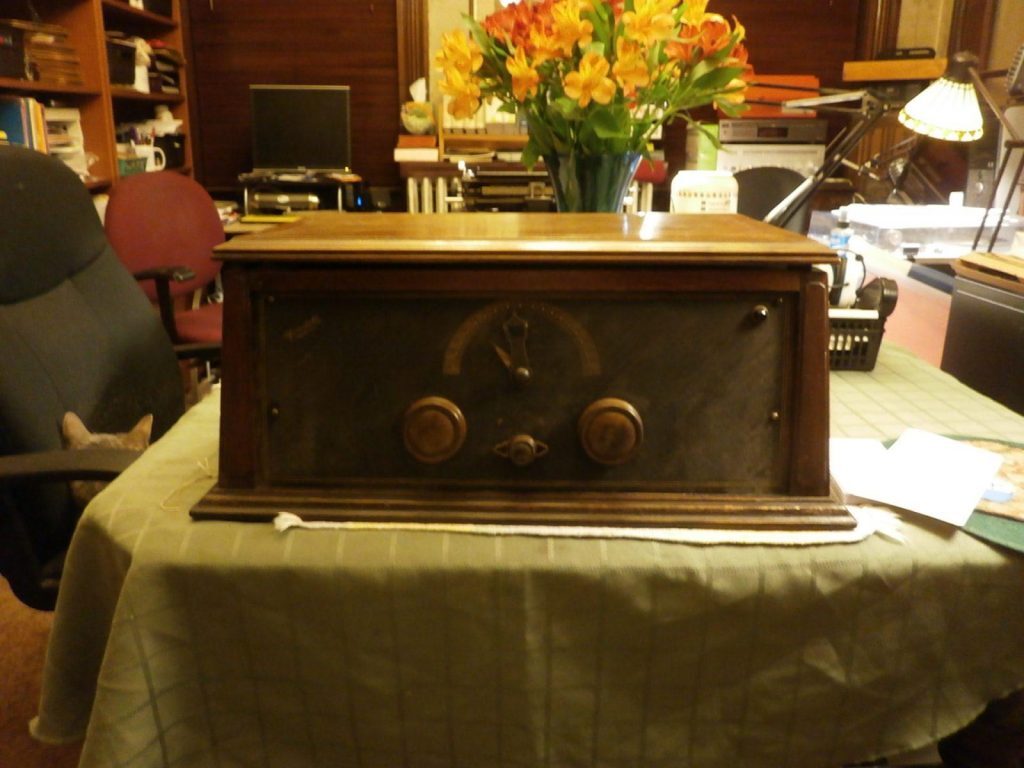(Related Story: Hot Jazz Saturday Night Cancelled)
Most of my life I have been fascinated with radio. My childhood, of course, was dominated by television—because TV is always the loudest and flashiest thing in the house. It commands attention and kills conversation—and precludes the enjoyment of anything that isn’t television. Still, there was always a radio in the house, and certainly one in the car.
Our car radio was always tuned to the station that featured a local political phone-in program during the day and signed off at local sunset after a recitation of the entire rosary. The tuner might have been—or might as well have been—broken. Music was never played in our car and rarely in our house. By grade school I already loathed rock music, so that was fine with me. Some Beatles tunes crept in (courtesy the cover album by the Chipmunks) but I favored the usual kiddie records and (especially) a compilation of tunes from Gilbert and Sullivan. My mother listened to Ray Conniff and 101 Strings. Jazz was not heard.
When I began to listen to radio on my own, I scoured the dial for broadcasts of music that I found congenial. At night, I heard AM signals from far away that occasionally conveyed selections I liked. When I finally got an FM set, so-called “Beautiful Music” predominated. It was mostly syrupy elevator-grade stuff but there were tunes I liked. The nearest outpost of listenable music was 50 miles away—which, fortunately, I could receive.
It wasn’t until my early teens that I heard the sort of jazz that is the reason for this paper’s existence. I had a pile of miscellaneous 78s, some LP reissues of the big bands, and I knew who Louis Armstrong was, but I had not yet made the acquaintance of Bix Beiderbecke and Eddie Lang. I was not privy to the revelation of early Ellington. It was courtesy of radio host Ray Boyce (who, I am honored to say, is a reader of this publication) broadcasting on WCNY-FM in Syracuse, New York, that I first experienced those indispensable artists.
Would I have discovered them anyway? Eventually. Maybe. My sense is that if you don’t know something exists you’re not going to look for it. The beauty of radio is the serendipity of discovering, through the variety of recordings presented by a knowledgeable and passionate host, music that you don’t know how you ever lived without.
The big public radio stations in major cities—which have traditionally provided a platform for jazz and other specialized music genres—are lately (and regrettably) moving toward a 24-hour news-and-information cycle. The latest casualty of the homogenization of public radio is Hot Jazz Saturday Night, an invaluable program hosted by Rob Bamberger on WAMU-FM in Washington, D.C., for the past 38 years. The show has a legion of loyal fans who contribute generously to pledge drives.
The reason for the cancellation is simply that HJSN doesn’t “fit.” Andi McDaniel, WAMU’s senior director of content and news, said “Our research tells us the best way to serve the audience and region is a format that is predominantly news and smart talk,” she said. “Music just does not fit into the schedule. It’s not the best way to serve our audience.”
Shows replacing this irreplaceable show include Live from Here, a successor to A Prairie Home Companion (but with more mandolin playing), and Live Wire. Recently, I happened to tune in to our own homogeneous NPR affiliate, and I caught a few minutes of Live Wire. Members of the studio audience had been asked, “What’s the biggest secret you ever had to keep?” That isn’t “smart talk.” It’s artisanally stupid programming crafted to attract shallow listeners. It’s the equivalent of having one’s Facebook news feed read aloud.
What’s “smart” to me is a whole program devoted to the music of the Boswell Sisters—such as Rob Bamberger presented in early June. Not all wisdom is expressed in words. The depth and joy of good jazz transcends human chatter. Radio, once in the business of presenting a little bit of everything, is now almost entirely devoted to obnoxious yacking.
A few weeks before this writing, Joe Bebco, my Associate Editor, let me know of a local estate sale which consisted almost entirely of a vast collection of 1920s battery-operated radios. There were hundreds of the sets—and it took some coaxing to get me out of the house to look at them. In fact, it took several emails and a phone call to dislodge me from my moorings.
The collector, who had died suddenly in his early 60s, had lovingly amassed and restored to working order a literal houseful of these boxy receivers. I had never seen so many of the things in one place—room after room of them—and they were going at ridiculously cheap prices. Joe had already filled up his car twice, and I went back with him for a third time.
I bought four exquisite, fully-restored, museum-quality sets: an A.C. Dayton, an Adler-Royal, a Pfanstiel, and a Splitdorf. They are simply beautiful to look at. If one hooked up a battery eliminator and a loudspeaker, one would expect to hear Coon-Sanders’ Nighthawks or Vincent Lopez out of any one of them. I wish I could.
Out of respect for what radio used to be, I am content to let them sit in silence to reproach us for what radio has become. Somewhere, in far distant outer space, radio waves from 1925 bring glad tidings from Carleton Coon and Joe Sanders. Here on Earth, there is no more joy in Radioland.
If you read this far you may also enjoy the Associate Editor’s essay: A Spin of the Dial
Andy Senior is the Publisher of The Syncopated Times and on occasion he still gets out a Radiola! podcast for our listening pleasure.






















